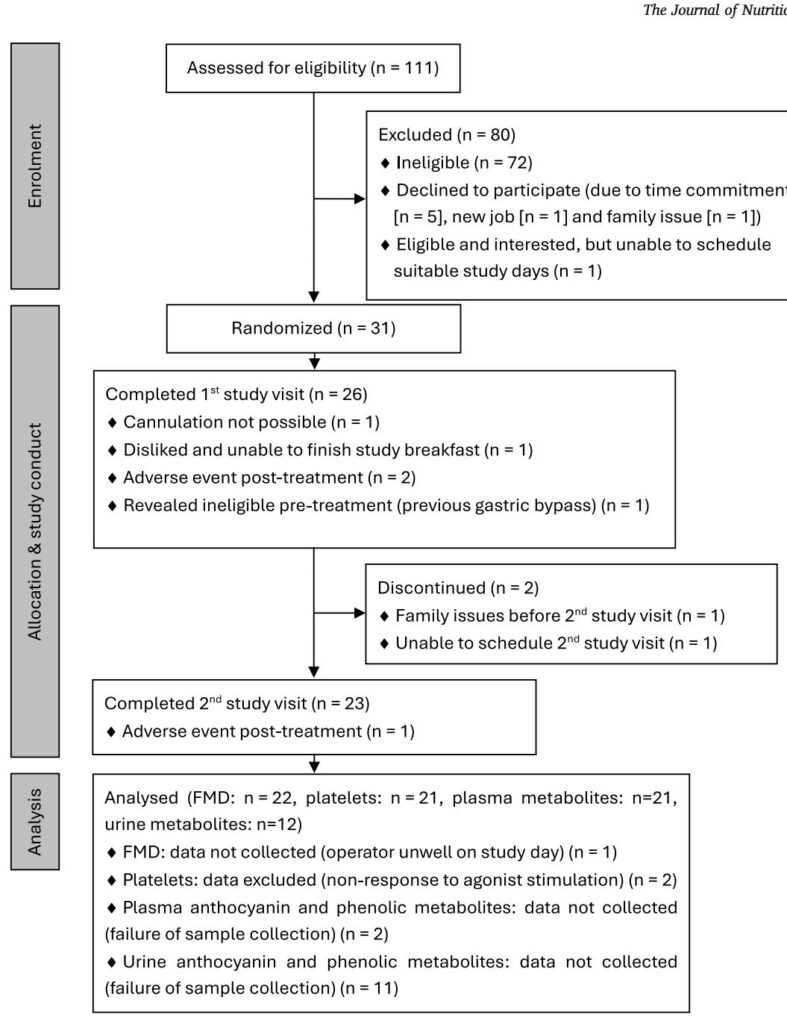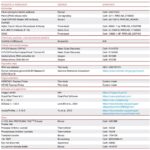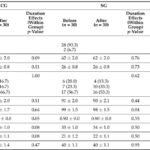Highlight
– An acute 200 mL blackcurrant beverage delivering ~711 mg anthocyanins improved cumulative flow‑mediated dilation (FMD) over 6 hours following a high‑fat meal compared with a matched placebo in healthy middle‑aged adults.
– The beverage reduced ex vivo platelet aggregation to ADP and collagen and abolished a postprandial rise in plasma interleukin‑8 (IL‑8); several specific plasma phenolic metabolites (hippuric acid, isovanillic acid, isoferulic acid glucuronide) were independently associated with these effects.
Study background and disease burden
Dietary polyphenols, and anthocyanins in particular, have been associated in epidemiologic studies with lower cardiovascular disease (CVD) risk and improved vascular biomarkers. Endothelial dysfunction and enhanced platelet reactivity are proximate mechanisms promoting atherothrombosis after dietary and metabolic challenges (e.g., high‑fat meals). Acute interventions that attenuate postprandial endothelial impairment and platelet activation could therefore have mechanistic and potentially clinical relevance for CVD prevention. However, clinical evidence specifically testing anthocyanin‑rich interventions under a postprandial challenge is limited.
Study design
This randomized, double‑blind, placebo‑controlled crossover trial (NCT02459756) enrolled 23 healthy nonsmoking adults (mean age ~39.9 ± 8.1 y; BMI 22.9 ± 2.3 kg/m2; 11 females). Each volunteer completed two visits separated by ≥3–4 weeks, consuming either a 200 mL blackcurrant beverage (containing 744 mg total polyphenols, ≈711 mg anthocyanins; delphinidin and cyanidin derivatives predominate) or a matched placebo lacking polyphenols but matched for sugars and flavoring. On each study day participants consumed the assigned beverage together with a standardized high‑fat breakfast (≈52.3 g fat) and a lunch at 3 hours (≈30 g fat) to model a realistic postprandial challenge.
Primary endpoints: flow‑mediated dilation (FMD) of the brachial artery and ex vivo platelet aggregation (ADP‑ and collagen‑stimulated). Secondary/exploratory endpoints included systolic and diastolic blood pressure (SBP/DBP), digital volume pulse indices (DVP‑SI, DVP‑RI), circulating endothelial‑ and platelet‑derived extracellular vesicles (EDEVs, PDEVs), plasma IL‑8, and plasma/urinary phenolic metabolites. Blood and urine were sampled serially up to 24 h; vascular measures were performed at baseline and at 1–6 h post‑intake.
Key findings
Flow‑mediated dilation (FMD)
– The blackcurrant beverage produced a significant cumulative improvement in FMD compared with placebo across the 6‑hour postprandial period. Incremental AUC (iAUC) for FMD favored blackcurrant with a mean ΔiAUC of 5.75 ± 1.32 (95% CI 2.99–8.51; P = 0.014). The mixed model indicated strong main effects for treatment and time.
Changes from baseline in FMD after consumption of the blackcurrant beverage or the placebo together with a high-fat breakfast.
Platelet aggregation
– Ex vivo platelet aggregation stimulated by ADP (10 μM and 100 μM) and collagen (0.5 and 1 μg/mL) was reduced after the blackcurrant beverage compared with placebo. iAUC comparisons showed significant reductions for ADP 10 μM (ΔiAUC −30.8 ± 8.7; P < 0.01) and 100 μM (ΔiAUC −18.6 ± 4.1; P < 0.001), and for collagen at both concentrations (P values <0.01–0.001). These effects indicate a cumulative antiplatelet effect over the postprandial window.
Inflammation and blood pressure
– Plasma IL‑8: The expected postprandial rise in IL‑8 seen with placebo was absent after the blackcurrant beverage. The iAUC for IL‑8 favored blackcurrant (ΔiAUC −1826.8 ± 618.6; 95% CI −3121.5 to −532.2; P = 0.015 unadjusted).
Changes from baseline in IL-8 concentrations after consumption of the blackcurrant beverage or placebo together with a high-fat breakfast.
– Blood pressure: The mixed model showed a treatment effect for SBP (P = 0.015 unadjusted) and a trend for DBP (P = 0.054 unadjusted). iAUC differences for SBP and DBP were not statistically significant after adjustment for multiple comparisons; these secondary results are exploratory.
Vascular stiffness and extracellular vesicles
– No acute effects were observed on DVP‑derived stiffness (DVP‑SI) or reflection indices (DVP‑RI) or on circulating EDEVs/PDEVs in this healthy cohort.
Plasma and urinary metabolites (mechanistic correlates)
– Targeted metabolomics detected multiple phenolic metabolites in plasma and urine after blackcurrant intake. Plasma vanillic acid, isovanillic acid, ferulic acid glucuronide, isoferulic acid glucuronide, and cyanidin glucuronide increased acutely (1–4 h).
– Multivariate regression identified plasma isovanillic acid and hippuric acid as independent predictors of FMD, together explaining ~21.3% of FMD variance. Isoferulic acid glucuronide and 4‑hydroxybenzaldehyde emerged as predictors of DBP and SBP respectively (explaining 4.7% and 16.5% of variance), and 3‑hydroxybenzoic acid predicted IL‑8 (≈9.2% variance).
Safety and tolerability
– Three participants experienced adverse events (two on blackcurrant, one on placebo) leading to withdrawal (vomiting/unspecified cannula discomfort); no serious adverse events occurred. The intervention dose (~711 mg anthocyanins) corresponds roughly to ~120 g fresh blackcurrants and was generally well tolerated in this screened healthy population.
Expert commentary and interpretation
Clinical relevance: The observed acute improvement in FMD is notable because small changes in FMD relate to meaningful differences in cardiovascular risk at the population level; for example, a 1% increase in FMD has been associated with ≈13% lower risk of cardiovascular events in meta‑analyses. The simultaneous attenuation of platelet reactivity and IL‑8 suggests pleiotropic vascular benefits that include endothelial protection, anti‑inflammatory activity, and reduced thrombogenicity in the postprandial period.
Mechanistic plausibility: Anthocyanins are rapidly metabolized; parent compounds were not detected in plasma, whereas multiple conjugated and microbially derived metabolites appeared within 1–4 h. The associations between specific metabolites (isovanillic acid, hippuric acid, isoferulic glucuronide) and physiological responses support a model in which anthocyanin biotransformation products mediate endothelial and platelet effects, possibly via increased NO bioavailability, antioxidant activity, modulation of inflammatory signaling (e.g., NF‑κB), and direct effects on platelet signaling pathways. These mechanisms align with prior blueberry and cocoa studies that linked plasma phenolic metabolites to vascular function.
Limitations and caveats
- Acute design: This trial assesses immediate postprandial responses; long‑term persistence and clinical outcome benefits remain unknown.
- Sample size and demographics: The study was small (n=23 completers) and enrolled healthy, normal‑to‑overweight middle‑aged adults without overt CVD or major risk factors, limiting generalizability to older or high‑risk populations.
- Potential confounding: While macronutrients and sugars were matched, the blackcurrant beverage contained trace minerals (potassium, calcium, magnesium) not present in the placebo formulation; these differences could influence BP acutely and should be accounted for in future studies using fully matched matrices.
- Exploratory analyses: Secondary outcomes and metabolite correlations were not adjusted for multiple comparisons and therefore carry an elevated risk of type‑I error. Associations do not demonstrate causality between specific metabolites and clinical effects.
- Dose: The anthocyanin dose used (~711 mg) is high relative to habitual intakes and may not be achievable daily for many people without concentrated products; dose‑response relationships require study.
Conclusion and clinical implications
In a randomized, double‑blind crossover trial, a single dose of an anthocyanin‑rich blackcurrant beverage consumed with a high‑fat meal produced a cumulative improvement in endothelial function (FMD) and reduced ex vivo platelet aggregation and IL‑8 over a 6‑hour postprandial period in healthy middle‑aged adults. Specific circulating phenolic metabolites correlated with these physiological benefits, implicating anthocyanin biotransformation products in the acute biological activity.
These findings strengthen mechanistic rationale for dietary anthocyanins as modulators of postprandial vascular stress. However, before recommending routine therapeutic use, we need randomized long‑term trials in at‑risk populations to evaluate durability of effects, dose–response, safety, and impact on hard cardiovascular endpoints. Future studies should also compare whole‑food sources versus standardized extracts, fully match placebo matrices (including mineral content), and investigate isolated candidate metabolites or metabolic pathways revealed here.
Practical takeaways for clinicians
– Anthocyanin‑rich foods (berries, concentrated blackcurrant products) can produce measurable acute improvements in endothelial function and reduce platelet reactivity after a high‑fat meal in healthy adults.
– Consider discussing berry intake as part of dietary strategies to reduce postprandial vascular stress, recognizing that evidence for long‑term cardiovascular benefit from anthocyanin supplementation is not yet definitive.
– Await further trials that address longer duration, at‑risk populations, fully matched placebos, and mechanistic validation of candidate metabolites before firm therapeutic recommendations.
References
Amini AM, Zhou R, Austermann K, Králová D, Serra G, Ibrahim IS, Corona G, Bergillos-Meca T, Aboufarrag H, Kroon PA, Spencer JP, Yaqoob P. Acute Effects of an Anthocyanin-Rich Blackcurrant Beverage on Markers of Cardiovascular Disease Risk in Healthy Adults: A Randomized, Double-Blind, Placebo-Controlled, Crossover Trial. J Nutr. 2025 Jul;155(7):2275-2289. doi: 10.1016/j.tjnut.2025.05.017 IF: 3.8 Q2 . Epub 2025 May 23. PMID: 40414296 IF: 3.8 Q2 ; PMCID: PMC12308090 IF: 3.8 Q2 .





